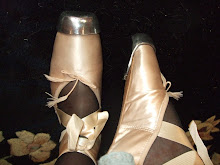
In this blogI am going to try to explain the difference between the ballet (pointe ) and toetap.They both use the ballerinas pointe shoe the difference is the stance .While en pointe a ballerina has the working leg straight along the body axis,elongating the leg . A ballerina use all the muscles in the lower body and her core to pull her up through the stance of pointe . The general rule for alignment in ballet. Is shoulders over ribs over hips over knees over toes. Everything is completely straight up and down. A ballet dancer use's a turnout for each of the 5 classical ballet positions involves lower extremity motion that occurs primarily through hip external rotation. (see definitions) A ballerina dances on top of the floor trying to feel it .Trying to be silent quite as a mouse.In Toetap the Tapperina or dancer which ever you wish to call yourself. In Toetap the most important thing is to relax. Toetap or Pointe-tap the dancer takes more of a tap dancers stance .The body relaxes using the "the Rad tap technique" The Rad Tap technique is doing for tap (by Rosie Raditor)as the Perfect pointe book is going for ballet (by Lisa Howell)Here is what they said about Rad-tap technique on Dancer Universehttp://danceruniverse.com/stories/issues/200403/rosie-radiator-tap-technique-supershuffle/"In Rad Tap the dancer is able to make fast close to the floor sounds that are heard but not seen," Rosie explains. "A technical approach teaches dancers to feel the small muscle contractions in the upper leg that stimulate and trigger many of the fastest sounds in tap. Isometric isolation's that are natural to your body produce sound through the feet. When this technique is mastered, it is invisible and produces dancers who look like they were born dancing""Tap is such a natural dance form that when you look at it, your body begins to identify with the movement," she says. "It's not like ballet. The lazier and more comfortable you are, the more you can access this pathway. Plus, there's a pleasure endorphin that's released behind the kneecap when the foot is relaxed and the kneecap is gently squeezing." She hesitates. "I'm not sure we should tell the world that. They might make it illegal."( written by - Jeannette Batz Cooperman )With the body and leg relaxed, the knee relaxes and bends slightly breaking the ballerinas line of the leg. This alone will drive a trained ballerina crazy while using a pointe shoe ! With the knee slightly bent the body relies more on the calf and thigh muscles to stabilise you through the movement. If you can't yet, get it the image, think of a tap dancer in a toe loop .Using a regular tap shoe on there shoe tips tapping away. It is the same knee bent body stance except en point . The upper body is like a ballerinas straight. This is a fusion dance .As with any of my posts I want you to remember a pointe shoe is deceptively simple in looks, yet hard to master .Many things can go wrong, if not taught by a teacher .The same thing with tap while doing a toe loop is is a hard thing to do you must have strong ankles and be taught by a teacher . Many things can go wrong.Definitions:Ballet Turnout:Ballet turnout refers to the outward rotation of the legs and feet. There are five basicballet positions of the feet. All ballet movements begin, end, or pass through at least oneof these positions. In all five positions, the knees are straight and the legs rotated outwardfrom the hips (figure 1).In ballet, the generally recognized ideal turnout of 180 degree took several centuries tobecome commonplace. In fact, in the 17th century the standard angle of turnout was only90 degrees. Greater degrees of turnout gradually developed because of their aestheticappeal and the freedom of movement they allowed the turnout leg. By the 18th century,the angle of ideal turnout had reached the present-day standard of 180 degrees.Dancers ideally achieve 180 degrees of turnout by rotating each hip out 70 degrees,rotating the knee out 5 degrees, and rotating the feet out 15 degrees, thereby adding up180 degrees of 2 - legged turnout. Typical ballet dancers have significantly less than 70degrees of outward hip rotation. Studies demonstrate measurements between 40-52degrees of outward rotation. Realistically, few dancers can achieve this angle withoutcompensations else where in the body. These compensations may be allowed and evenencouraged by dance instructors who stress the importance of ideal turnout.Unfortunately, forceful compensation for reduced hip outward rotation can, and oftendoes, lead to many of the injuries seen in dancers.Toetap: is a 1920 name for a dance style of dancing . When the dancer tapped out a series of steps ,while on toe. In today's terms Toe dancing, on toe or toe shoes are frowned upon in the ballet world . In today's terms it is viewed as en pointe or pointe shoes or pointe / tap.Consultation by Selly of http://www.danceoutlook.com/


No comments:
Post a Comment